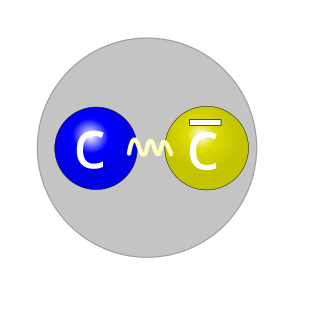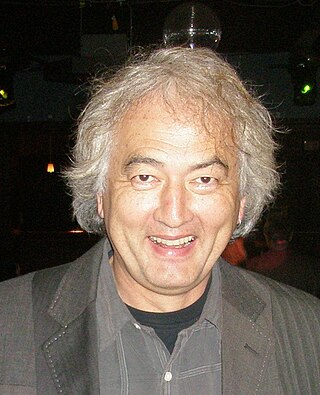Related Research Articles

A gluon is an elementary particle that acts as the exchange particle for the strong force between quarks. It is analogous to the exchange of photons in the electromagnetic force between two charged particles. Gluons bind quarks together, forming hadrons such as protons and neutrons.

In particle physics, annihilation is the process that occurs when a subatomic particle collides with its respective antiparticle to produce other particles, such as an electron colliding with a positron to produce two photons. The total energy and momentum of the initial pair are conserved in the process and distributed among a set of other particles in the final state. Antiparticles have exactly opposite additive quantum numbers from particles, so the sums of all quantum numbers of such an original pair are zero. Hence, any set of particles may be produced whose total quantum numbers are also zero as long as conservation of energy, conservation of momentum, and conservation of spin are obeyed.

The Large Hadron Collider (LHC) is the world's largest and highest-energy particle collider. It was built by the European Organization for Nuclear Research (CERN) between 1998 and 2008 in collaboration with over 10,000 scientists and hundreds of universities and laboratories, as well as more than 100 countries. It lies in a tunnel 27 kilometres (17 mi) in circumference and as deep as 175 metres (574 ft) beneath the France–Switzerland border near Geneva.

The Relativistic Heavy Ion Collider is the first and one of only two operating heavy-ion colliders, and the only spin-polarized proton collider ever built. Located at Brookhaven National Laboratory (BNL) in Upton, New York, and used by an international team of researchers, it is the only operating particle collider in the US. By using RHIC to collide ions traveling at relativistic speeds, physicists study the primordial form of matter that existed in the universe shortly after the Big Bang. By colliding spin-polarized protons, the spin structure of the proton is explored.

The
J/ψ
(J/psi) meson is a subatomic particle, a flavor-neutral meson consisting of a charm quark and a charm antiquark. Mesons formed by a bound state of a charm quark and a charm anti-quark are generally known as "charmonium" or psions. The
J/ψ
is the most common form of charmonium, due to its spin of 1 and its low rest mass. The
J/ψ
has a rest mass of 3.0969 GeV/c2, just above that of the
η
c, and a mean lifetime of 7.2×10−21 s. This lifetime was about a thousand times longer than expected.

High-energy nuclear physics studies the behavior of nuclear matter in energy regimes typical of high-energy physics. The primary focus of this field is the study of heavy-ion collisions, as compared to lighter atoms in other particle accelerators. At sufficient collision energies, these types of collisions are theorized to produce the quark–gluon plasma. In peripheral nuclear collisions at high energies one expects to obtain information on the electromagnetic production of leptons and mesons that are not accessible in electron–positron colliders due to their much smaller luminosities.
Hadronization is the process of the formation of hadrons out of quarks and gluons. There are two main branches of hadronization: quark-gluon plasma (QGP) transformation and colour string decay into hadrons. The transformation of quark-gluon plasma into hadrons is studied in lattice QCD numerical simulations, which are explored in relativistic heavy-ion experiments. Quark-gluon plasma hadronization occurred shortly after the Big Bang when the quark–gluon plasma cooled down to the Hagedorn temperature when free quarks and gluons cannot exist. In string breaking new hadrons are forming out of quarks, antiquarks and sometimes gluons, spontaneously created from the vacuum.
Quark matter or QCD matter refers to any of a number of hypothetical phases of matter whose degrees of freedom include quarks and gluons, of which the prominent example is quark-gluon plasma. Several series of conferences in 2019, 2020, and 2021 were devoted to this topic.

A jet is a narrow cone of hadrons and other particles produced by the hadronization of a quark or gluon in a particle physics or heavy ion experiment. Particles carrying a color charge, such as quarks, cannot exist in free form because of quantum chromodynamics (QCD) confinement which only allows for colorless states. When an object containing color charge fragments, each fragment carries away some of the color charge. In order to obey confinement, these fragments create other colored objects around them to form colorless objects. The ensemble of these objects is called a jet, since the fragments all tend to travel in the same direction, forming a narrow "jet" of particles. Jets are measured in particle detectors and studied in order to determine the properties of the original quarks.

In particle physics, the parton model is a model of hadrons, such as protons and neutrons, proposed by Richard Feynman. It is useful for interpreting the cascades of radiation produced from quantum chromodynamics (QCD) processes and interactions in high-energy particle collisions.
Color-glass condensate (CGC) is a type of matter theorized to exist in atomic nuclei when they collide at near the speed of light. During such collision, one is sensitive to the gluons that have very small momenta, or more precisely a very small Bjorken scaling variable. The small momenta gluons dominate the description of the collision because their density is very large. This is because a high-momentum gluon is likely to split into smaller momentum gluons. When the gluon density becomes large enough, gluon-gluon recombination puts a limit on how large the gluon density can be. When gluon recombination balances gluon splitting, the density of gluons saturate, producing new and universal properties of hadronic matter. This state of saturated gluon matter is called the color-glass condensate.

Quark–gluon plasma is an interacting localized assembly of quarks and gluons at thermal and chemical (abundance) equilibrium. The word plasma signals that free color charges are allowed. In a 1987 summary, Léon van Hove pointed out the equivalence of the three terms: quark gluon plasma, quark matter and a new state of matter. Since the temperature is above the Hagedorn temperature—and thus above the scale of light u,d-quark mass—the pressure exhibits the relativistic Stefan-Boltzmann format governed by temperature to the fourth power and many practically massless quark and gluon constituents. It can be said that QGP emerges to be the new phase of strongly interacting matter which manifests its physical properties in terms of nearly free dynamics of practically massless gluons and quarks. Both quarks and gluons must be present in conditions near chemical (yield) equilibrium with their colour charge open for a new state of matter to be referred to as QGP.
R-hadrons are hypothetical particles composed of a supersymmetric particle and at least one quark.

Johann Rafelski is a German-American theoretical physicist. He is a professor of physics at the University of Arizona in Tucson, guest scientist at CERN (Geneva), and has been LMU-Excellent Guest Professor at the Ludwig Maximilian University of Munich in Munich, Germany.
In high-energy nuclear physics, strangeness production in relativistic heavy-ion collisions is a signature and diagnostic tool of quark–gluon plasma (QGP) formation and properties. Unlike up and down quarks, from which everyday matter is made, heavier quark flavors such as strange and charm typically approach chemical equilibrium in a dynamic evolution process. QGP is an interacting localized assembly of quarks and gluons at thermal (kinetic) and not necessarily chemical (abundance) equilibrium. The word plasma signals that color charged particles are able to move in the volume occupied by the plasma. The abundance of strange quarks is formed in pair-production processes in collisions between constituents of the plasma, creating the chemical abundance equilibrium. The dominant mechanism of production involves gluons only present when matter has become a quark–gluon plasma. When quark–gluon plasma disassembles into hadrons in a breakup process, the high availability of strange antiquarks helps to produce antimatter containing multiple strange quarks, which is otherwise rarely made. Similar considerations are at present made for the heavier charm flavor, which is made at the beginning of the collision process in the first interactions and is only abundant in the high-energy environments of CERN's Large Hadron Collider.

John William Harris is an American experimental high energy nuclear physicist and D. Allan Bromley Professor of Physics at Yale University. His research interests are focused on understanding high energy density QCD and the quark–gluon plasma created in relativistic collisions of heavy ions. Dr. Harris collaborated on the original proposal to initiate a high energy heavy ion program at Cern in Geneva, Switzerland, has been actively involved in the CERN heavy ion program and was the founding spokesperson for the STAR collaboration at RHIC at Brookhaven National Laboratory in the U.S.
Olga Evdokimov is a Russian born professor of physics at the University of Illinois, Chicago (UIC). She is a High Energy Nuclear Physicist, who currently collaborates on two international experiments; the Solenoidal Tracker At RHIC (STAR) experiment at the Relativistic Heavy Ion Collider (RHIC), Brookhaven National Laboratory, Upton, New York and the Compact Muon Solenoid (CMS) experiment at the LHC, CERN, Geneva, Switzerland.
Claude Pruneau is a Canadian-American experimental high-energy nuclear physicist. He is a Professor of Physics at Wayne State University and the author of several books. He is best known for his work on particle correlation measurements in heavy ion collisions at the Relativistic Heavy Ion Collider and the Large Hadron Collider.
Reinhard Stock is a German experimental physicist, specializing in heavy-ion physics.
References
- ↑ D. H. Perkins (2000). Introduction to High Energy Physics, Cambridge University Press.
- ↑ Gross, David J.; Wilczek, Frank (25 June 1973). "Ultraviolet Behavior of Non-Abelian Gauge Theories". Physical Review Letters. 30 (26): 1343–1346. Bibcode:1973PhRvL..30.1343G. doi: 10.1103/physrevlett.30.1343 .
- ↑ Adcox, K.; et al. (PHENIX Collaboration) (2002). "Suppression of Hadrons with Large Transverse Momentum in Central Au+Au Collisions at √sNN = 130 GeV". Physical Review Letters. 88 (2): 022301. arXiv: nucl-ex/0109003 . doi:10.1103/physrevlett.88.022301. PMID 11801005. S2CID 119347728.
- 1 2 Adler, C.; et al. (STAR Collaboration) (26 February 2003). "Disappearance of Back-To-Back High-pT Hadron Correlations in Central Au + Au Collisions at √sNN = 200 GeV". Physical Review Letters. 90 (8): 082302. arXiv: nucl-ex/0210033 . doi:10.1103/physrevlett.90.082302. PMID 12633419. S2CID 41635379.
- ↑ "LHC experiments bring new insight into primordial universe" (Press release). CERN. November 26, 2010. Retrieved December 2, 2010.
- ↑ Aad, G.; et al. (ATLAS Collaboration) (13 December 2010). "Observation of a Centrality-Dependent Dijet Asymmetry in Lead-Lead Collisions at √sNN = 2.76 TeV with the ATLAS Detector at the LHC". Physical Review Letters. 105 (25): 252303. doi: 10.1103/physrevlett.105.252303 . PMID 21231581.
- ↑ Chatrchyan, S.; et al. (CMS Collaboration) (12 August 2011). "Observation and studies of jet quenching in Pb-Pb collisions at √sNN = 2.76 TeV". Physical Review C. 84 (2): 024906. doi: 10.1103/physrevc.84.024906 . hdl: 1721.1/67342 .
- ↑ CERN (18 July 2012). "Heavy ions and quark-gluon plasma".